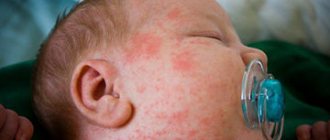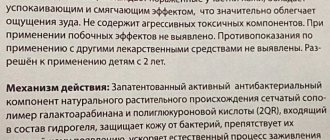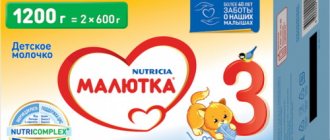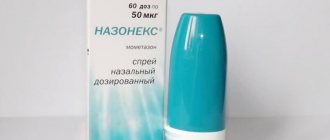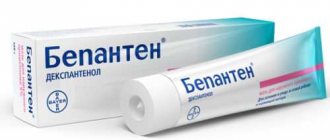Aquadetrim is a medication that is responsible for the normal metabolism of phosphorus and calcium.
- Pharmacology and pharmacodynamics
- Why do they drink Aquadetrim?
- How to take Aquadetrim drops correctly
- Contraindications and adverse reactions
- How to give Akvadetrim to a child
- How to give Akvadetrim to a baby correctly
- Can pregnant women take Aquadetrim?
- Where should Aquadetrim be stored?
- What is the best replacement for Aquadetrim?
- special instructions
- How much does Aquadetrim cost?
Can a baby be allergic to Aquadetrim?
Can infants be allergic to Aquadetrim? Of course they can, and it occurs quite often. And this is due to the fact that synthesized vitamin D is inherently a strong allergen. Therefore, it is so important that the pediatrician calculates the required dosage in order to prevent oversaturation with this component. But not only oversaturation contributes to the development of allergies, there is an increased sensitivity to the substances included in the drug. It is important for parents to closely monitor the child’s condition during the period of administration of the vitamin preparation and, if a reaction begins to appear, a mandatory visit to the doctor is recommended. In order to correctly recognize an allergy, you should study its symptoms and characteristics.
Indications for use of the drug
The drug is a viscous transparent substance with a characteristic anise aroma. One milliliter of the drug includes fifteen thousand units of vitamin D. In addition, the product contains other auxiliary components.
A sufficient amount of cholecalciferol contributes to the correct and timely development of bone tissue. With a lack of vitamin D, children's bodies do not fully absorb incoming calcium. This process can trigger abnormal bone growth.
Aquadetrim
The drug helps improve muscle tone, regulates blood clotting, parathyroid glands, and myocardium. Vitamin D enters the human body with food, but its main source is sun rays. A newborn, as a rule, does not fully receive this component, since there is no variety in food, and walks are usually not enough to replenish the necessary reserves.
Based on this, almost all children are prescribed Aquadetrim up to a certain age. The pediatrician, depending on height and weight, prescribes the required dosage.
Important! An adult should not independently prescribe an aqueous solution of vitamin D3 to a child, as this can cause an allergic reaction due to oversaturation with the vitamin.
Also, before the appointment, it is taken into account what kind of feeding the baby is on, artificial or breastfeeding. This is due to the fact that most formulas already contain vitamin D3, and in this case a smaller dosage of the drug will be needed compared to breastfeeding. The main indications for the use of the drug are the following factors:
- In order to prevent a lack of cholecalciferol in the body;
- In the treatment of rickets, rickets-like pathologies;
- With hypocalcemia;
- With metabolic osteopathy;
- For osteoporosis.
Important! An allergic reaction to the drug in ninety percent of cases manifests itself in the first twelve months of life.
Causes of an allergic reaction to synthetic vitamin D
Aquadetrim is an allergenic drug. Factors in the occurrence of allergies to synthetic vitamin D3 can be both the components themselves included in the composition of the drug and the peculiarity of its use. As mentioned earlier, cholecalciferol is a very strong allergen, so treatment and prevention should be carried out exclusively by a pediatrician. Many point out that the main reason for an overdose is the inconvenient bottle, from which either one drop or several can come out at once. Therefore, sometimes the child receives a large dose of the vitamin.
Note! For proper dosing of the drug, it is recommended to use a pipette.
It was revealed that allergies can be triggered by anise flavor and benzyl alcohol included in the drug. Allergic reactions can also appear with a reduced dosage, therefore, to accurately determine individual intolerance to Aquadetrim, it is recommended to study all the signs and features of the manifestation.
Drug overdose
Signs of a drug overdose in infants are the following symptoms:
- The child refuses to eat;
- Often capricious, sleeps poorly;
- Frequent crying may be a sign of headache or general weakness;
- Constipation, flatulence leading to bloating;
- Another sign is an increase in overall body temperature to 38 degrees Celsius.
If the above symptoms appear, it is recommended to stop using Aquadetrim. If the established norm is slightly exceeded, the baby does not require additional drug therapy; the reported symptoms will go away after a few days.
Pharmaceutical preparation with vitamin D3
Many patients who are indicated for the use of vitamin D are prescribed the drug "Aquadetrim". An analogue of this drug, like the medicine itself, is dispensed from pharmacies without a doctor’s prescription. “Aquadetrim” is a liquid with a characteristic anise smell, poured into a glass bottle with a pipette tip. Each bottle is packed in a separate cardboard box. One bottle of Aquadetrim contains 10 ml of medicinal liquid, 1 ml of which contains 15,000 IU of cholecalciferol - vitamin D3, precisely the one that is produced by body tissues under the influence of ultraviolet radiation.
Reviews from young mothers
Svetlana, 26 years old.
“At first I associated the redness of my son’s cheeks with his diet. I removed everything possible from my diet, but it didn’t help.
Then I decided to check the reaction to Aquadetrim, did not give this drug for several days, and the skin completely cleared up. As soon as I applied the product again, by evening my cheeks turned red again.
Therefore, the pediatrician advised us to replace Aquadetrim with an oil solution of vitamin D3. So far so good."
“After Aquadetrim, we began to have problems with our tummy - bloating, sometimes we had diarrhea several times a day. The pediatrician said that this is how the child might react to anise and therefore suggested replacing the drug with Vigantol. After a few days of using it, my tummy problems went away.”
“I gave Aquadetrim to my son almost from birth. The vitamin was tolerated normally, I did not notice any side effects. Now we are almost a year old and it’s summer, so I think there is no need to take it.”
“The pediatrician prescribed us Aquadetrim, one drop at a time, from the third week of birth. On the first day, the baby cried for a long time and slept poorly. And on the second day of taking Aquadetrim, a rash appeared on the body. I stopped taking the drug myself, we haven’t taken it for three days now and everything has returned to normal. Tomorrow we will go to the pediatrician for another treatment.”
“About a month after starting to take Aquadetrim, I noticed a periodic appearance of a rash on the child’s body. At first I thought it was diaper rash or an allergy to the powder. But then I noticed that the rash became smaller if I forgot to give this vitamin. Now I’ve reduced the dosage to one drop and, to be honest, sometimes I skip taking the vitamin and don’t notice any more pimples on my body.”
Useful reading: Allergies in children. causes, symptoms, treatment.
Rickets will not go away!
Prevention of various diseases is more rational than treatment of emerging diseases. This primarily concerns young children and infants. But for a baby to be born healthy, his mother must be healthy. During pregnancy, a woman should receive much more of all the necessary vitamins and minerals in order not only to maintain her health, but to bear and give birth to a healthy child. The drug "Aquadetrim", instructions for use, price, reviews, analogues of which help both the doctor and the patient correctly navigate the use of a prophylactic drug, is one of the most popular drugs containing cholecalciferol - vitamin D3.
Take care of yourself and be healthy!
How does an allergy to Aquadetrim manifest itself?
Since the drug is prescribed orally, a specific reaction occurs inside the body, releasing toxic substances that contribute to the appearance of allergic symptoms on the skin, nervous, and digestive systems.
General symptoms of pathology
In infants, allergies are expressed in the following symptoms:
- Redness of the skin is observed. The symptom appears in the form of red spots forming on the face and throughout the body;
- Then the itchy skin rash begins;
- Peeling begins on the child’s arms, legs, and cheeks;
- Flatulence is observed, leading to either diarrhea or constipation;
- Loss of appetite, the child refuses to eat;
- Allergens affect the child’s nervous system, causing him to become irritable, whiny, and sleep poorly.
It is also worth noting that the listed symptoms may also occur due to other circumstances. Therefore, it is important to seek medical help and get the right treatment.
Forms of allergic reaction in infants
Symptoms caused by an allergy to Aquadetrim in infants can have two forms of reaction. The first of which is a specific form, characterizing the presence of an allergen in the body. The second form of allergic reaction is divided into two types:
- An allergic reaction caused by substances that are similar in structure but different in essence. This form is called paraallergy;
- The second form occurs due to a weakened immune system, chronic disease, hypothermia and other unfavorable factors.
Establishing the correct form of an allergic reaction in infants occurs as a result of a medical examination and testing.
Non-hormonal drugs
Often, 1st generation antihistamines are not used to treat allergic reactions in children, as they cause drowsiness, liver dysfunction, cardiovascular problems, and also reduce visual acuity. In this regard, it is recommended to use 3rd generation drugs, which include Zyrtec, Trexil, Claritin. In case of a severe allergic reaction, local treatment is necessary. In this case, the use of antihistamine non-hormonal ointments is indicated. These drugs practically do not cause any adverse reactions; they are well tolerated by babies up to one year old. By using medications according to the recommendations of a specialist, it will be possible to eliminate redness and severe itching, while activating regeneration processes. Unfortunately, the effectiveness of the product used cannot be observed immediately. In this case, it is advisable to begin treatment with hormonal drugs, which will almost immediately eliminate the observed symptoms and improve the general condition of the child.
How to identify pathology?
Since the above symptoms may also occur due to other reasons, it will be necessary to obtain confirmation of the presence of sensitivity to the components of Aquadetrim. This procedure is carried out by collecting anamnesis and general examination. The following information is collected:
- The connection between the manifestation of the first signs and the start of the infant taking a vitamin preparation is clarified;
- An objective regression of negative consequences is revealed after completion of Aquadetrim administration;
- Clarification of the presence of similar reactions during past use.
After taking a medical history, your doctor may order laboratory tests and skin testing.
Vitamin D
How to take vitamin D while breastfeeding mother
You should not decide to take funds on your own, especially during breastfeeding. In this regard, it is necessary to consult a specialist. Before use, you should read the instructions. In no case should you exceed a certain dosage for breastfeeding. It is important to carefully monitor the body during the first days of use in order to prevent individual intolerance to some components of the drug. In addition, the active substances should be taken in a course, following all the instructions of the manufacturer and the attending physician.
Diagnostics
The diagnosis is based primarily on the history and physical examination of the young patient:
- the connection between the violations that have arisen and the start of taking the medication is revealed;
- objective regression of symptoms is observed after discontinuation of the drug;
- whether there was a similar reaction to Aquadetrim in the past;
- characteristic signs indicating an allergy to Aquadetrim.
Laboratory studies in young children have a low level of information content. Collection of analyzes and diagnostic samples are carried out in extreme cases.
The possibility of replacing the drug with a hypoallergenic analogue makes in-depth diagnostics unnecessary. It is enough to consult with a pediatrician on the selection of an effective safe analogue and its dosage.
How to treat an allergy to Aquadertim?
Once the exact cause of the allergic reaction is identified, the doctor will prescribe individual treatment depending on the patient’s age and the severity of the disease.
Treatment of infants up to 1 month
If a baby up to one month is allergic to Aquadetrim, then the following therapeutic treatment is preferentially prescribed:
- Children should be left alone;
- The presence of heavy drinking;
- Feeding restrictions;
- If necessary, take an antipyretic drug;
- A day walk is required;
- If bloating occurs, it is recommended to take dill water.
Therapy for young infants
To make the process of treating an allergic reaction easier for infants to understand, antihistamines such as Ebastine, Zyrtec, Claritin, Fenistil, Trexil are prescribed. External medications can also be prescribed to relieve itching and speed up the process of skin regeneration. These include non-hormonal drugs such as Bepanten, D-Panthenol, Skin-cap. If treatment does not produce visible results, the doctor may prescribe corticosteroid therapy, which promotes the appearance of blood cells and relieves the inflammatory and allergic process. Additionally, potassium, magnesium, and a vitamin complex may be prescribed.
Elimination
Elimination is the complete rejection of the suspected allergen. When conducting an accurate diagnostic examination and identifying the component that provokes the allergy, the sin of consuming Aquadetrim helps to improve overall well-being within two days. If a child is advised to continue taking vitamin D3, the doctor will prescribe alternative options.
Fish fat. How much vitamin D is in foods
What should I use instead of Aquadetrim?
In most cases, pediatricians prescribe the following analogues of Aquadetrim:
- Vigantol;
- D-type;
- Vitamin complex Multi-tabs;
- Oily vitamin D3 - ergocalciferol.
The interchangeable drug and dosage are prescribed exclusively by pediatricians.
Nutrition for infants with allergies
The nutrition of infants during treatment for allergies with Aquadetrim changes due to the presence of more abundant drinking. When breastfeeding, it is advisable for the mother to avoid fatty, salty, and spicy foods. You should also avoid eating citrus fruits, strawberries, whole cow's and goat's milk, nuts, mushrooms and canned food. You should make sure that the mixture also does not contain cow or goat milk proteins.
Composition of drops
The vitamin preparation “Aquadetrim” is prescribed for use for preventive purposes even in infants. It is convenient to give it to babies, as it comes in liquid form. Its composition is as follows:
- cholecalciferol, that is, vitamin D3, which contains 15,000 IU in 1 ml;
- macrogol glyceryl ricinoleate is a polymeric substance that can be in different states of aggregation; in this medicinal product it is a liquid;
- sodium hydrogen phosphate dodecahydrate - an inorganic compound that acts as an emulsifier;
- citric acid monohydrate - liquid medicine acidity regulator;
- benzyl alcohol is used to disinfect oil preparations;
- anise flavor gives the vitamin product a pleasant aroma;
- water allows you to bring the required concentration of the drug to the desired value.
Hormonal agents
Preparations for external use with antiallergic effects can be divided into four groups depending on the intensity of their action. It is recommended to start treatment with weak hormonal drugs that will definitely not harm the child.
Creams and ointments with corticosteroids should be used with extreme caution, as addiction develops with long-term therapy and should be discontinued gradually. Along with this, long-term use can provoke hormonal imbalance in the baby’s body.
Helpful tips for prevention
In order to prevent the occurrence of allergies to the use of Aquadetrim in advance, it is recommended to follow the following steps:
- Strict adherence to the dosage prescribed by the doctor;
- Choosing a mixture together with the treating pediatrician;
- The initial input is an aqueous solution. This is due to the fact that the baby’s body is not yet able to fully digest fats.
It should be remembered that small children have a very difficult time tolerating various synthetic substances. Therefore, it is recommended to replenish the necessary vitamins in a natural way. Caring for children includes daily walks, a proper feeding diet, adherence to a daily routine and a mandatory scheduled examination by the attending physician.
Vitamin supplements are essential for the development of strong bones. Artificial vitamin D Aquadetrim (sometimes also called Aquadetrin) is most often produced in drops, and doses are introduced into the body in the form of a solution through a pipette. Despite all the positive benefits, this method has the potential to cause an overdose and, as a result, toxicity of synthetic vitamin D with life-threatening symptoms. At the same time, the lack of this essential vitamin is dangerous for adults and children.
D3 for infants from the first weeks of life
A newborn child requires careful attention to his health from the very first days of life, because it is at this time that children grow and develop most actively. Missed problems in the development of the skeletal system threaten huge problems.
Rickets is a scary word for all parents. Many of them believe that daily long walks in the open air will protect the baby from serious problems with the skeletal system. But due to the characteristics of the baby’s body and all the processes that are just beginning to strengthen and develop as necessary, the production of vitamin D by the baby’s skin may be disrupted.
For preventive purposes, pediatricians prescribe vitamin preparations containing vitamin D to all children. The pharmacy chain offers several such preparations, for example, Aquadetrim. Analogues that are cheaper than this remedy can also be found for the prevention of rickets in infants.
One of the most popular is the Russian drug Ergocalciferol. It is great for kids as it has no taste or smell. Just like other similar medications and prophylactics, it can be given to a child from 4 weeks of life. The dose of a specific drug is prescribed by the pediatrician, taking into account the health status of the baby, his living conditions, and the mother’s pregnancy history.
Drugs for the prevention of rickets and other complications of bone tissue are usually prescribed for use in the autumn-winter-spring period, leaving the natural ultraviolet radiation of the sun to summer. But according to reviews from parents of children, the drug “Aquadetrim” is most often prescribed. Analogues for infants must meet the safety requirements for the use of drugs for infants. So, for example, Baby D Drops, containing 400 IU per 1 mg of the substance, is based on coconut oil, which can cause allergies.
Can you be allergic to Aquadetrim?
The definition of an allergy to Aquadetrim in a child refers to food intolerance to the excipients in the composition of a vitamin supplement with the manifestation of symptoms and signs of an allergic nature. Aquadetrim, which is relevant among pediatricians, includes sucrose or a substance such as citric acid, which are potential allergens. The body is able to limit the amount of vitamin D absorbed through exposure to sunlight. Vitamin D production is endogenous. Can you be allergic to Aquadetrim? Liquid supplements may bypass this natural defense and cases of toxicity may occur. At the same time, vitamin supplements help relieve seasonal allergic reactions and chronic hives, which manifests itself in babies as a red rash that is first noticed on the cheeks.
The role and usefulness of calciferols
The vitamin is naturally present as a source in only some foods and is available as a dietary supplement in the form of, for example, Aquadetrim.
Benefit:
- Vitamin D promotes the absorption of calcium in the intestines.
- It is essential for bone growth and remodeling.
- Vitamin D receptors are expressed in many cell types, including various immune cells, suggesting its role in the immune system.
The most active form is vitamin D3 (cholecalciferol). It is synthesized in the skin upon exposure to ultraviolet radiation from sunlight or obtained directly from the diet and functions as a hormone, being converted into calcitriol. Biologically inert cholecalciferol undergoes two hydroxylations to be activated in the body: in the liver, where it is converted into 25-hydroxyvitamin D (25(on)D) or calcidiol; in the kidneys, where physiologically active 1,25-dihydroxyvitamin D (1,25(on)2D) or calcitriol is formed.
Vitamin D for infants is a high priority immediately after birth. On the one hand, it regulates the exchange of phosphate and calcium. In addition, it enhances the incorporation of calcium into the baby's bones and teeth.
But its effects on the innate and adaptive immune systems are much broader. The active form of the vitamin (calcitriol) has effects on epithelial cells, T cells, B cells, macrophages and dendritic cells.
Unfortunately, the answer to the question: can a child be allergic to Aquadetrim is positive.
Why is rickets dangerous?
Vitamin D deficiency in infants develops a wide range of skeletal abnormalities that vary depending on age and stage of development:
- wrist extension;
- bowed legs;
- craniotabes (softening and thinning of the skull (mainly in the occipital and parietal bones) usually in newborns);
- dystrophy of the ribs (chondritis costalis);
- spinal deformity;
- disturbances in linear growth and developmental delay are common;
- Infants may exhibit symptomatic hypocalcemia.
Worldwide, the most common cause of rickets in children is vitamin D deficiency, which leads to secondary hyperparathyroidism and progressive renal failure with phosphate retention.
However, the etiology may be multifactorial, as calcium deficiency tends to exacerbate the effects of marginal vitamin D status and further interact with other nutritional deficiencies, particularly iron deficiency.
How to find the cause of an allergy? — Dr. Komarovsky
Allergens
Vitamin D is a protective factor for the development of food allergies. Its deficiency increases the risk of food sensitivity, which can progress into allergies. As a result, an allergic person may experience allergic symptoms to more than one food. But the auxiliary components in the composition of the drugs can affect the risk of an allergic reaction.
Function of vitamin D in the body
Vitamin D deficiency has been reported in half the world's population. Its deficiency can have various clinical signs. Infants develop rickets.
The main function is to control the metabolic processes of calcium and phosphoric acid salts. This promotes normal mineralization and formation of the skeletal system. The active substance of vitamin D3, cholecalciferol (or colecalciferol), is involved in the absorption of calcium and phosphoric acid salts from the intestinal tract, in the distribution of mineral salts, and in strengthening bones with calcium.
Improves the removal of calcium and phosphates by the kidneys. Calcium ions in the blood maintain the tone of the skeletal muscles, the functioning of the cardiac myocardium, conduct nervous stimulation, and regulate blood clotting. Cholecalciferol is necessary for the smooth functioning of the parathyroid glands and participates in the functioning of the body's protective functions.
The work of vitamin D is not limited to its influence on the processes of bone tissue formation. Its deficiency affects the development of chronic diseases of the cardiovascular system, diabetes, and oncological pathologies. Vitamin D deficiency increases the risk of developing autoimmune diseases. Prolonged sun exposure during childhood and early adolescence is associated with a reduced risk of developing multiple sclerosis. Much attention is paid to the role of vitamin D in reducing the risk of developing mental disorders, in particular schizophrenia and affective disorders.
How the reaction manifests itself - symptoms
Not only a deficiency of vitamin D, but also an excess of it administered with the drug can lead to serious health problems. Allergy to Aquadetrim - how does it manifest itself? A high overdose affects the body even with short-term administration. Symptoms of poisoning appear, suffer from nausea, and react to high levels of calciferol with vomiting, fatigue and headache. Extreme thirst is also a sign of overdose.
Sun exposure, even in large quantities, does not cause toxicity, since the constant heat applied to the skin is a photodefect of previtamin D3 (and vitamin D3 in the process of its formation). Moreover, thermal activation of previtamin D3 gives rise to various forms of non-vitamin D, limiting the formation of the vitamin itself. Taking the vitamin directly from food is also an unlikely factor for poisoning. This phenomenon most often occurs due to inadequate consumption of appropriate nutritional supplements.
Symptoms of allergic reactions often include angioedema or swelling of the lips, face, tongue and throat, itchy skin, and hives. Gastrointestinal problems may not occur immediately, but after about a couple of hours.
Not only D3, but also D2
Vitamin D3 is the main active ingredient of the drug "Aquadetrim". It is a regulator of calcium absorption in the human body, and therefore is responsible for the sustainable mineralization of the entire bone apparatus. But not only vitamin D3 is used for preventive and therapeutic purposes. The pharmacy offers substitutes for Aquadetrim, for example, the drug D-calcine, which contains vitamin D2. You can also purchase another drug containing vitamin D - Ergocalciferol. It has been produced by the pharmaceutical industry for decades and has helped raise several generations of children without rickets. In addition to ergocalciferol itself - vitamin D2 - its composition includes deodorized, refined, frozen sunflower oil, in which the vitamin dissolves well.
Let's sum it up
An allergy to Aquadetrim is quite possible. But before attributing changes in a child’s well-being or skin to taking a vitamin, it is necessary to exclude other possible causes of such changes. And this can be done with the help of a doctor.
The child's body urgently needs vitamin D, which regulates phosphorus and calcium metabolism and promotes the proper development of the organs of a small child. An allergy to Aquadetrim should not go unnoticed by parents. It is necessary to discontinue the drug and consult with your doctor to replace it with a safe analogue.
Sunshine vitamin
People love the sun. It gives light and warmth and allows you to grow all kinds of plants. But, among other things, it is under the influence of sunlight that a very important vitamin is produced in human skin, which is called vitamin D. It is sometimes called the sun vitamin. Although, if you look more precisely, its synthesis involves the ultraviolet rays of the sun, the same ones that give the skin a tanned hue while relaxing in the summer fresh air. Vitaminology has established that a vitamin of this group is not one substance, but several similar to each other. They are designated by the same letter, but with different indices. As a pharmaceutical product, we are most often talking about vitamins D2 - ergocalciferol, and D3 - cholecalciferol. The analogue of "Aquadetrim D3" should contain vitamin D, but with index 3. Why? It is this component that is formed in the tissues of the human body and some animals under the influence of ultraviolet radiation.
Treatment
How much vitamin D does a child need?
A three-hour exposure to air during the daytime is 9 mcg, breast milk contains from 0.55 mcg to 1.50 mcg (per liter of milk). Thus, breastfeeding and daily walks do not meet the needs of vitamin D, do not replace it, and to avoid problems of developing deficiency, supplementation is necessary.
The amount of vitamin D produced by daylight or consumed in food varies with the seasons. During the winter months, when the lack of ultraviolet light sharply reduces in-house production, demand is higher. In addition, due to the cold, almost all parts of the human body are covered with clothing, so the formation of provitamins is a big question. An alternative is quartz lamps, the UV component of which promotes the production of vitamin D in the body, and taking vitamin complexes.
How to help with an overdose?
Vitamin D is fat soluble. This means that the child's body will need time to get rid of it in the event of an overdose. A physical examination is necessary to determine whether an infant is getting too much of the vitamin. Only a doctor can measure the amount of calcium and vitamin D in the blood.
Vitamin D overdose
List of medications for children from 6 months
In many cases, non-drug treatments are the best choice for quick recovery. Clear liquids (water, juice, broth) will help children avoid dehydration due to vomiting, diarrhea, sweating and nasal discharge. If your child has nasal congestion, drops of saline (salt water) will thin the nasal discharge. But if necessary, when a child needs medications that relieve the painful and itchy symptoms of allergic reactions, the following can be recommended:
- anti-inflammatory drugs – Acetaminophen and Ibuprofen;
- antihistamines - Diphenhydramine, Zyrtec and Claritin.
